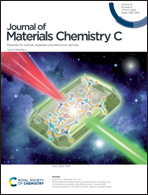Encapsulation of 2D MoS2 nanosheets into 1D carbon nanobelts as anodes with enhanced lithium/sodium storage properties†
Abstract
Molybdenum disulfide (MoS2), which is a two-dimensional transition metal chalcogenide, has been considered to have great lithium/sodium storage potential. However, its poor conductivity, unsatisfactory mechanical stability and large volume change upon cycling make MoS2 not well applied in practice. Herein, MoS2@C nanobelts (MoS2@C NBs), which possess the nanostructure of MoS2 nanoflakes completely encapsulated within an amorphous carbon layer, were obtained by utilizing MoO3 nanobelts as self-sacrificing templates, followed by a facile thermal decomposition of solution-evaporated glucose and an in situ hydrothermal sulfidation process. This unique nanostructure provides not only good electrical conductivity and short ion diffusion length, but also excellent structure stability. When applied in lithium-ion batteries (LIBs) and sodium-ion batteries (NIBs), the nanobelts exhibit enhanced electrochemical properties. In LIBs, the nanobelts deliver a high discharge capacity of 1189 mA h g−1 after 200 cycles at 0.2 A g−1 and a long-cycle stability of 626 mA h g−1 even after 800 cycles under 1 A g−1. Furthermore, excellent rate capabilities of 1133, 1180, 1078, 926, 704 and 1249 mA h g−1 at 0.1, 0.2, 0.5, 1 and 0.1 A g−1, respectively, are also acquired. As for NIBs, after 100 cycles at 0.2 A g−1, a charge capacity of 328.8 mA h g−1 can be maintained and the retention rate is 83.2%.



 Please wait while we load your content...
Please wait while we load your content...